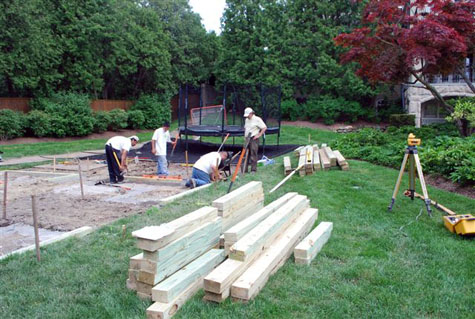

I am late getting to the posting today-but I did manage to get planted all 32 giant pots for the City of Birmingham. Not that my crew isn’t eminently capable of this; I am always the lame one. This year I was determined to get every pot designed, transfer that design to a piece of paper in a readable form, assemble the material, and help load. Diana and her crew take care of the rest-I did not hear from her all day. Except at 4:30-her call that everything was done. She rocks. 
This vegetable garden, with a must complete date of June 6 is coming to a construction close . We have set the 14 foot tall beech arbor, underplanted it with asparagus, (put your imagination to work about how this will look in 3 years) built the vegetable boxes, and planted the columnar apple trees from Henry Luthardt. We installed drain tile, excavated soil and installed a decomposed granite surface to walk on. How I love the sound of gravel underfoot-and this 3/8 inch and down decomposed granite compacts hard enough to take a pair of Jimmie Choo 4 inch heels without the slightest dent. In the center, an herb theatre, with steel arches reminiscent of the Roman aquaducts. Tomorrow we plant the “wild at heart” apple espaliers, install the tomato cage/obelisks, and the tomatoes, plant the vegetables, rhubarb and strawberries. We need to doll up the grade in one spot, and resod. Today, the irrigation is getting installed. Copper, with spray risers. I like the look of overhead irrigation-its beautiful. I hate drip irrigation-it clogs, and malfunctions-you can’t spot any malfunction until things are crisp. And the water is never where you want it, with drip. Drip irrigation is a great idea that the reality is not where it should be. For now, I like water when I can see it. And I like how this garden is at the fun tune-up stage. My most favorite part of a job coming to a close, is washing off the walks, and terraces. Washing off the digging, the sweating, the agonizing over this choice or that. This feeling lasts the better part of 3 seconds, as every gardener knows no garden is ever finished. It is either going backwards or going forwards. No neutral. 
Garden Under Construction
Made in Michigan

My exasperation with UPS shipping regulations partially fueled my decision to make garden ornament. They have a 105 inch rule: the length of a box, plus the diameter of its width, cannot exceed 105 inches. What vine trellis is tall enough at 105 inches? What plant stake is tall enough? Anything bigger has to be shipped motor freight, at much greater expense. The other part of my decision was feeling like the design of such structures was not the best-could a tuteur not be beautiful with nothing on it? Or holiday lights on it for the winter? Why are all plant supports invariably straight sided? Most of the plants I think need support are small coming out of the ground, and floppy at the top. Why are plant stakes only 4 feet tall, with no length to put below ground for stability? 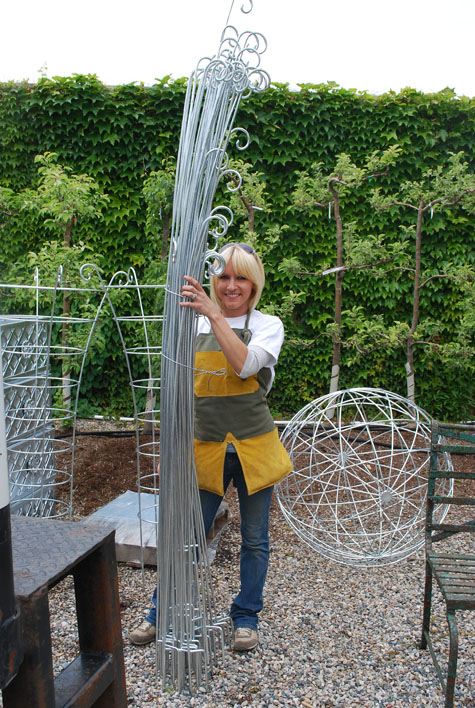
Why are they straight poles-with no arc that mimics the natural growth of a plant? A pole in the ground twists with the wind; why don’t plant stakes have prongs at the bottom?
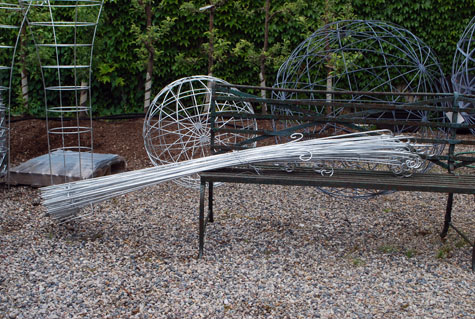 Why do plant stakes come to a point that could poke you, if you aren’t watching what you are doing? Why aren’t the tuteurs beautiful shapes??�
Why do plant stakes come to a point that could poke you, if you aren’t watching what you are doing? Why aren’t the tuteurs beautiful shapes??�
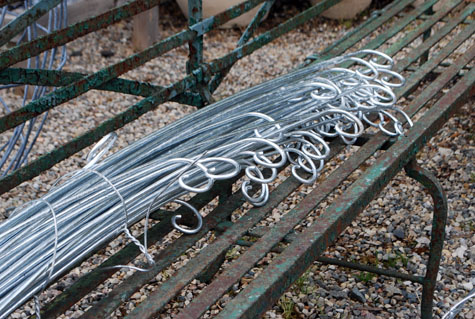
Some clematis grow to 10 feet,others much taller. Peonies need a different size suport system than a cherry tomato. Asparagus in my garden needs three rings, not two. My local clients, not needing UPS shipping, get properly scaled plant climbers and towers that fit their plants. And tuteurs that I think are beautiful and sculptural in their own right. �
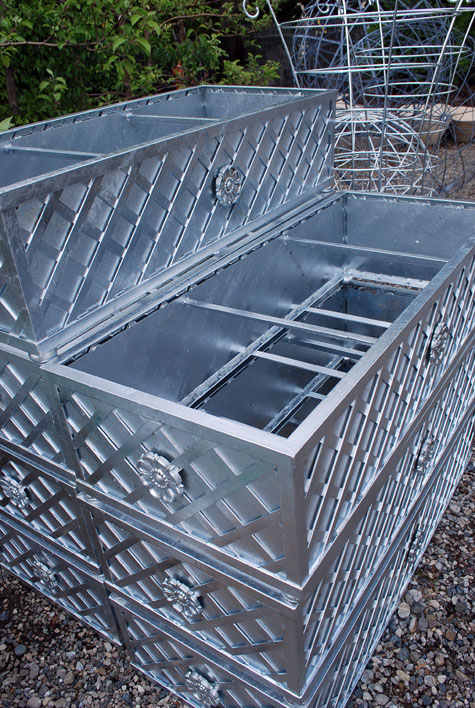
Rectangular boxes can be a perfect shape for certain locations. But ready made ones are always too long, or too short, or too tall, or too low. Designing ornament allows me to have control over that oft forgotten landscape element with regard to a specific space or garden.
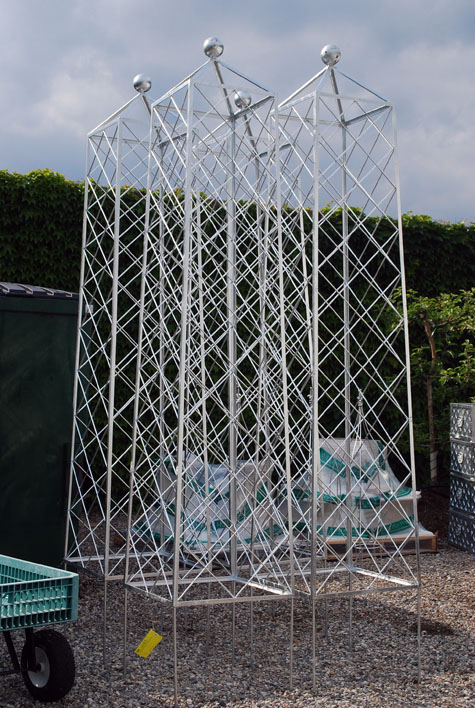
Steel and weather makes for a bad mix-unless you have a penchant for rust. A case in point, the Mackinac Bridge which spans the Upper and Lower Peninsula of Michigan , is perpetually being painted. Every day, every year. The paint is a rust inhibitor, not a rust proofing. Rust can weaken steel-not a good thing for a bridge 5 miles long. The worst effects of rust in a garden is stains on your khakis, or your limestone caps. So our first step towards a virtually maintenance free finish on steel is to haul our things to a galvanizing plant. Each item is attached with hooks to a rack; this assembly is then lowered into a bath of molten zinc. Thus the term “hot dip ” galvanizing.
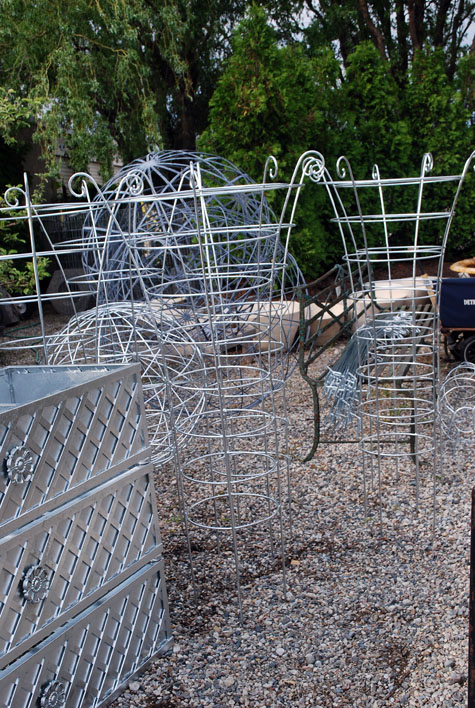
The galvanizing is protection only insofar at the item is completely immersed, so it coats every surface entirely. We have our tricks for spot finishing those areas that sometimes get left uncoated. This is the stage that gleams bright, and looks brand spanking new. Our final coat involves acid; this treatment turns the silver to a streaky black-gray color, very reminiscent of lead. This color helps fit the object into the landscape-as if it had always been there.�

The Niwashi

This time of year I multitask- meaning cocktail hour is also a planting hour. It takes a long time for me to plant one hour at a time-but I like this arrangement. I like taking the time to reflect on what I am doing-this is a luxury. Buck sometimes comes to keep me company, or help out a little .(how amusing to me that he does not like dirt on his hands or raindrops on his glasses; he’d rather walk on top of the low limestone walls than on the grass.) My architect is urban through and through-but he will help out if I ask; ask I did yesterday. One small bed I plant is always rife with wiry maple tree roots; its a headache digging those roots out before I plant. I managed to talk him into this job, as I had a new tool, a gift from a good friend and client. Buck cannot resist a new tool, still in its box, that he’s never tried before, so I knew he’d fall for it.
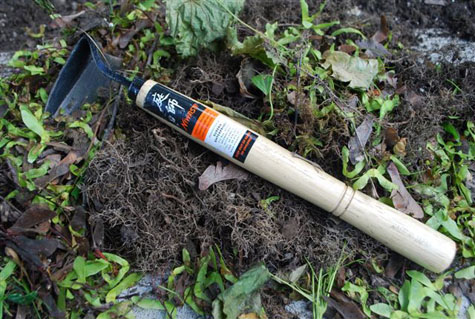
The Niwashi is an amazing tool. My friend bought one while on a trip to New Zealand-she says its the only tool she uses in her garden. She ordered one for me. It has turned out to be such a fabulous present. When I saw what fast work Buck was making of a tiresome chore, I had to try it myself. Obviously I have never gardened with a really sharp tool. Light, razor sharp, angled perfectly to cut weeds on top or roots underneath the soil surface-where has this tool been all my gardening life? �

I was ready to plant in no time; the Niwashi made it possible for me to plant with my hands. I vastly prefer this method to using a trowel. So properly prepped soil is a must. This 4.5 inch tricolor geranium is rooted top to bottom, but not rootbound-perfect to plant. It will transplant easily, and readily take hold. Though my scheme this year is orange and red violet , I like a little leavening. This geranium has a gorgeous cream based leaf with hints of my colors. Some variegated foliage is difficult to pair with green leaved plants; not this one. The orange flower is a modest bonus-but its the leaves I love. I have seen it called “Skies of Italy”-there’s some romance.�
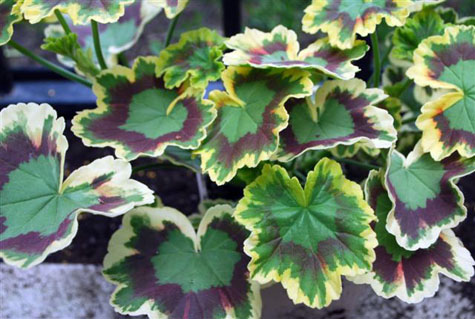
The driveway bottom bed is planted and watered, as is 1/2 of the top bed, in no time. Thanks a million, Jane. For those of you who might want to check out all of their tools, www.niwashi.co.nz.�
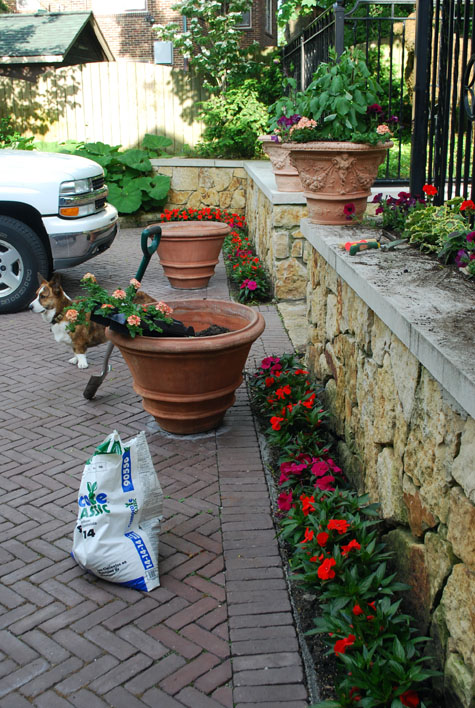
Last year’s scheme was entirely dictated by a pair of baby pink fuchsia standards called “Ballerina”. I liked the whole thing just fine. But what’s not to love about being able to do things differently?
Forty-Four Degrees
It was 44 degrees when I got to work at 7 am this morning. Only the pansies, lettuce, annual phlox, snap peas,and a few others, go for this. The angelonia, sweet potato vine, New Guineas impatiens, lantana and a whole host of others, despise it. Many nurseries sell vegetables early, and then sell them over again after late frosts damage them or kill them. The cold spring weather is a perennially hot topic for Michigan gardeners.
Every year’s struggle to get everyone’s flowers planted in a very small time frame, is all the more complicated by the weather. The annual flowers we use are definitely not native to Michigan. Most of them come from warm, even hot tropical regions where the soil is never really cold. I don’t like to plant any of these plants until the night temperatures are reliably above 50. It is May 31st today; we have yet to get there. Should you put a finger in the soil today, it will be surprisingly chilly. Air warms up, and cools off, much more quickly than soil.
I am of the opinion that planting too early stunts the growth of tropical plants. I have seen impatiens and begonias never recover from too early planting; I hear regularly “this was not a good year for my impatiens”. Having a good year with flowers actually depends quite a bit on some good horticulture. People sabotage their plantings, as they have the option of deciding when to plant. It isn’t the weather; late May cold is a regular feature of our spring.
I often buy early, to get what I want, and hold. They say delayed gratification is an adult pleasure-but that doesn’t make it easier for me to wait. Vastly more difficult than waiting, is persuading my clients that they should wait. I have had occasion to ask a client to sign off on a planting I knew was too early, and I have planted a few of those gardens twice in one spring. I don’t like doing this, as its a waste of time and money-never mind that I can’t stand dead plants on my hands when I knew perfectly well how to keep them alive.
This part may be much more intuition than science. I believe a later planting pays off at the end of the season. By this I may mean a week later. I rarely plant my own annuals before June 15-nothwithstanding those people who think the summer is half over by June 15. My plants take hold faster, and perform in every way superior to plants put in too early. I am always taking my pots apart in November, not because the flowers have gone down, but because I am just tired of taking care of them. I don’t stress my annuals by planting too early, not watering sufficiently, not deadheading, grooming and fertilizing. I think I have them longer, given this treatment. I try not to worry my plants with too much of my own nonsense. Should I plant early, I know the result belongs to me, not the Michigan May weather.